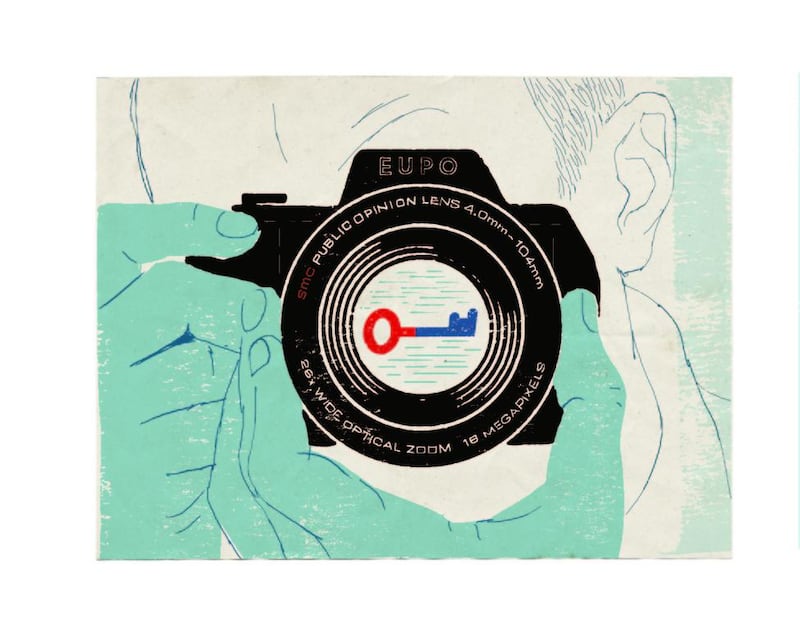In December 1984, in the swirling dust that had engulfed a refugee camp along the Pakistan-Afghanistan border, photographer Steve McCurry’s camera was transfixed by the soul-piercing gaze of a 12-year-old girl. McCurry had not yet realised it, but he had just captured “Afghan Girl”, one of the most iconic images of our times.
Such decisive clicks can shift political discourse, propel public introspection and provoke landmark changes in policy. The photo became the cover of National Geographic but its impact outlasted that month’s edition of the magazine. This single image birthed a children’s fund.
Over this summer, images from the refugee influx to Greece created a similar effect – particularly those of three-year-old Aylan Kurdi who drowned at sea. Suddenly, people across Europe experienced the images as mothers, fathers, grandparents and siblings. The reactions were primal. This sense of frustration and anger has created a new tide in public opinion towards the refugee influx into Europe. While challenging the roles and responsibilities of their respective countries, citizens are volunteering their time towards galvanising support for those arriving.
But, this seemingly uncontrollable surge, especially of Syrian refugees, is just the tip of the iceberg. From repeated internal displacement inside Syria to their inadvertent spillover into neighbouring countries, this cycle has been a recurring theme for years, reaching a stunning spike this summer.
Although inexcusably tardy, Europeans from northern countries are finally responding in significant numbers. Concurrent demonstrations were held under the banner of “Refugees Welcome” over September 12 and 13 in London, Copenhagen and Vienna. Scouring through stories of Samaritans driving to Hungary to provide transportation and provisions for those walking towards Germany and Austria, is enough to sense an unprecedented public reaction.
A friend who attended the pro-refugee gathering in Copenhagen remarked wryly, “I can’t believe we are simply standing there and showing the way to Sweden when we have so much space and even more to benefit from those arriving.”
While polls indicate that a majority of Danes want to accept refugees, the government has placed advertisements in Lebanon, urging refugees not to travel to Denmark by irregular means.
A colleague who lives in London was surprised by the level of public support during rallies, given the strong “anti-immigrant” rhetoric that dominated British politics in recent years. Others who had been working with refugees in cities like Catania and Athens well before the crisis commanded global attention, expect a short attention span from the masses.
But sustained public opinion can bring about changes in government commitments towards refugees and could stem future deaths at sea. It is vital that those taking to the streets understand how to push an effective agenda and where the pressure points lie.
While German chancellor Angela Merkel’s declaration that “all Syrians are welcome” in her country has been seen as humane, the ensuing overflow that capped the limit within a week quickly proved the recklessness of the call. Mrs Merkel shut the borders to the rest of the Schengen zone. Bolstered by her move, Hungary’s Viktor Orban, the most vociferous opponent of illegal migrants, resumed building his fence.
Years of apathy towards the Syrian crisis have come back to haunt Europe. The EU’s entire 2014 asylum influx accounted for a mere 0.03 per cent of its population. After four years of ignoring the flows into Italy and Greece while contributing to disastrous policies on Syria, Europe is now faced with a much more challenging task.
In a conflict that has claimed close to 300,000 lives, more than four million Syrians have fled to neighbouring countries, with a fraction of them having arrived in Europe. Meanwhile, 11 million are displaced inside the country.
Syrians left because of conflict and have become economically impoverished over years of being stranded in countries where they cannot work or create a new future for their families. If they saw a semblance of a future for their own country, they would stay closer to home as they mostly did in 2011 and 2012.
A majority of the Syrian refugees are arriving from the coast of Turkey. If Germany wants to afford protection to refugees, the most efficient way is to initiate a mass resettlement process in the Syrian camps of Turkey so that those seeking asylum do not take life-threatening voyages to enter Europe.
Given that Syrian refugees fork out thousands of dollars to smugglers, why not facilitate a legitimate resettlement process so they may use the same amounts towards flight tickets and asylum and enter Europe with their dignity and safety intact?
Photographs claiming to show ISIL fighters entering Europe as refugees have been circulating recently in sections of the international media. These photographs have been proven to be fake. While concern over the uncontrollable nature of migration are valid, this is yet another reason to push for coherent, orderly entry of asylum seekers through legitimate channels.
It is equally important that Europeans understand the impact of migrants and naturalised citizens on their national economies. Migrants tend to be the most honest taxpayers, take up jobs where gaps exist due to a national brain drain and often open up small-scale businesses, thereby spurring local economies. Refugees who are already university graduates are assets to the recipient countries without the expenses of educational investment. It is simply a matter of recognising their skills and putting them to use.
Even in cash-strapped Italy, which has Europe’s second oldest population, assimilated immigrants and their families can stimulate economies in areas that are nearly emptied of their younger working people.
In a majority of EU countries refugees stopped using social welfare benefits six months into finding employment.
So, while Germany might incur high costs in assimilating refugees, the long-term benefits of introducing a young labour force to an rapidly ageing country will be exponential.
But, when we debate the refugee crisis, let’s not play into the fear-mongering that ISIL has so effectively used to its advantage. Let’s not allow fabricated photographs of purported ISIL fighters dupe us into preventing a structured solution to the refugee flows. As Italian MP Giorgio Brandolin asserted, “There have been no confirmed [ISIS] cases, zero!”
Finally, let’s continue to be reactive to these unfolding events but with a proactive agenda in mind. Let’s not forget the basic facts until another decisive photograph appears on social media to reawaken our collective consciousness.
Preethi Nallu is working on a multimedia project called Parallel Journeys: Seasons of Migration that explores the Mediterranean crossings through individual narratives





